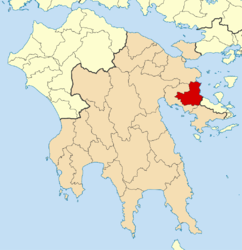Epidaurus
Ἐπίδαυρος | |
|---|---|
 | |
| Coordinates: 37°35′52″N 23°04′28″E / 37.59778°N 23.07444°E | |
| Country | Greece |
| Administrative region | Peloponnese |
| Regional unit | Argolis |
| Area | |
• Municipality | 340.4 km2 (131.4 sq mi) |
| • Municipal unit | 160.6 km2 (62.0 sq mi) |
| Population (2021)[1] | |
• Municipality | 7,030 |
| • Density | 21/km2 (53/sq mi) |
| • Municipal unit | 3,418 |
| • Municipal unit density | 21/km2 (55/sq mi) |
| Time zone | UTC+2 (EET) |
| • Summer (DST) | UTC+3 (EEST) |
| Postal code | 210 59 |
| Vehicle registration | AP |
| Official name | Sanctuary of Asklepios at Epidaurus |
| Criteria | Cultural: i, ii, iii, iv, vi |
| Reference | 491 |
| Inscription | 1988 (12th Session) |
| Area | 1,393.8 ha |
| Buffer zone | 3,386.4 ha |
Epidaurus (Greek: Ἐπίδαυρος) was a small city (polis) in ancient Greece, on the Argolid Peninsula at the Saronic Gulf. Two modern towns bear the name Epidavros: Palaia Epidavros and Nea Epidavros. Since 2010 they belong to the new municipality of Epidaurus, part of the regional unit of Argolis. The seat of the municipality is the town Lygourio.[2] The nearby sanctuary of Asclepius and ancient theatre were inscribed on the UNESCO World Heritage List in 1988 because of their exemplary architecture and importance in the development and spread of healing sanctuaries and cults across the ancient Greek and Roman worlds.[3]
- ^ "Αποτελέσματα Απογραφής Πληθυσμού - Κατοικιών 2021, Μόνιμος Πληθυσμός κατά οικισμό" [Results of the 2021 Population - Housing Census, Permanent population by settlement] (in Greek). Hellenic Statistical Authority. 29 March 2024.
- ^ "ΦΕΚ A 87/2010, Kallikratis reform law text" (in Greek). Government Gazette.
- ^ "Sanctuary of Asklepios at Epidaurus". UNESCO World Heritage Convention. United Nations Educational Scientific and Cultural Organization. Retrieved 12 November 2022.

